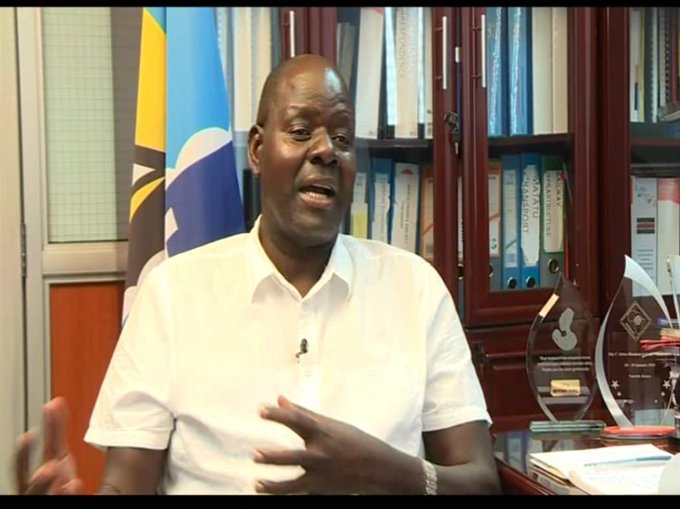|
Getting your Trinity Audio player ready…
|
By Baboloki Semele
The Chief Executive Officer of Centre for Transport, Infrastructure, and Regional Integration, and former CEO of LAPSSET Authority, Sylvester Kasuku says the Lamu Port-South Sudan-Ethiopia transport corridor program and free trade agreements have contributed meaningfully to the African integration agenda by bringing opportunities closer and reducing regional tensions.
He says the project constitutes the greatest land bridge ever planned on the continent, serving as a link to the belt and road initiative and spreading the impact of the 4IR all over Africa. He urged that in a bid to make positive strides, Africa must transform its population to be a business population that supports growth in Africa. Kasusku stated that the private sector is a key partner to governments and RECs in the successful implementation of the LAPSSET.
The LAPSSET Corridor is a regional flagship project intended to provide transport and logistics infrastructure aimed at creating seamless connectivity between the Eastern African countries of Kenya, Ethiopia, and South Sudan.
The project connects a combined population of 160 million people in the three people in the three countries and is part of the larger land bridge that will connect the East African coast from Lamu port to the west coast of Africa at Douala port.
Kasuku highlighted that the corridor has improved connectivity between Kenya, Ethiopia, and South Sudan, thus generating positive economic synergy between the three countries.
In an interview during the tour, the director of the transportation, and infrastructure department at the infrastructure concession regulatory commission, Emmanuel Onwodi noted that the developed economies may not be able to provide the required funding for this project, but urged for the exploration of alternative means of funding such as PPPs, loans from development finance institutions and tax credits to corporate institutions, including pension funds.
Ambassador Francis Kirimi Muthaura, chairperson of Kenya revenue authority said there is no alternative but to realize Lapsset’s transformative potential, adding that expediting approvals of mega projects would show that the region is serious about fixing its infrastructure projects, thereby attracting a huge number of investors.
Highlighting some of the solutions undertaken in Africa’s regional infrastructure such as building political consensus and getting high level buy in to move projects forward, and taking regional perspectives into the ground with developing national policies, Robert Lisinge, chief of the energy department at UNECA emphasized that working together is key for the success of Africa’s regional infrastructure programs. He further pointed out that collaboration has had limited success recently so far, as has been shown by the slow pace of implementation of tans border infrastructure projects. He says soft infrastructure interventions are also necessary to increase border and transport efficiency along trade corridors through a reduction in time and cost spent between the borders, considering also a number of documents necessary for import, export, and transit operations.
The 453-kilometre Lamu Port Development Road project network began in April 2021 and was estimated to take 24 months. It comprises the 257km section of the Lamu-Ijara-Garissa road, the 113km Hindi-Bodhei-Basuba-Kiunga road and the 83km Ijara-Sanghailu-Hulugho section.
With the projects having been hit by delays and security challenges, it is unclear whether the port, power plant, railway and other facilities from the Lamu port, through to South Sudan and Ethiopia will be completed on time.
So far, only construction of the $354 million first phase of the port has been completed. The second and third berths were completed in December leading to Kenya floating tenders for 20 more berths under a public private partnership plan.
Since the port became operational in May 2021, it has handled nine vessels and 1,619 twenty feet-equivalent units in its first berth, according to the Kenya Ports Authority database.
Kenya Lapsset Corridor Development Authority Chair Titus Ibui said there was a need to mobilise funds and improve on security to ensure the projects are completed.
Speaking to this publication during the tour of LAPSSET corridor, Mr. Ibui said a number of projects have stalled as a result of insecurity after suspected Al-Shabaab militants attacked residents and even contractors forcing the project implementers to flee.
“We are concerned about the insecurity in Lamu that is crippling progress of Lapsset projects. We have seen contractors suspend works due to insecurity but we are addressing that,” said Mr. Ibui.
On funding, Mr Ibui said Kenya has so far used up $1.39 billion in the construction of roads and other infrastructure from its coffers. He said the completion of the first phase in December last year put the port in a better position to start handling transit cargo after a successful transshipment test.
“We expect President Uhuru Kenyatta together with other leaders from the region to officially open the port after dry run for a year where it has handled transshipment cargo using one berth,” said Mr. Ibui.
The second and third berths in Lamu port are set to be opened in May this year, one year after the facility was commissioned for a dry run for transshipment. The second commercial port will start transit using the new road networks which have been completed within and outside the country targeting South Sudan and Ethiopia. Lapsset seeks to link the three States via rail, airports, roads, and oil pipelines. Under the project, Lamu is set to become Eastern Africa’s largest seaport with 23 berths.
According to the new plan, it will be implemented in two phases under the East-West Beltway corridor and land bridge.
The project adoption by the AU gives it sufficient mileage and exposure to attract foreign direct investment (FDI) and another financing.
The first phase will cover Lamu-Isiolo-Addis Ababa to Djibouti while the second phase will connect Lamu to Kribi/Doula via Juba and Bangui.
